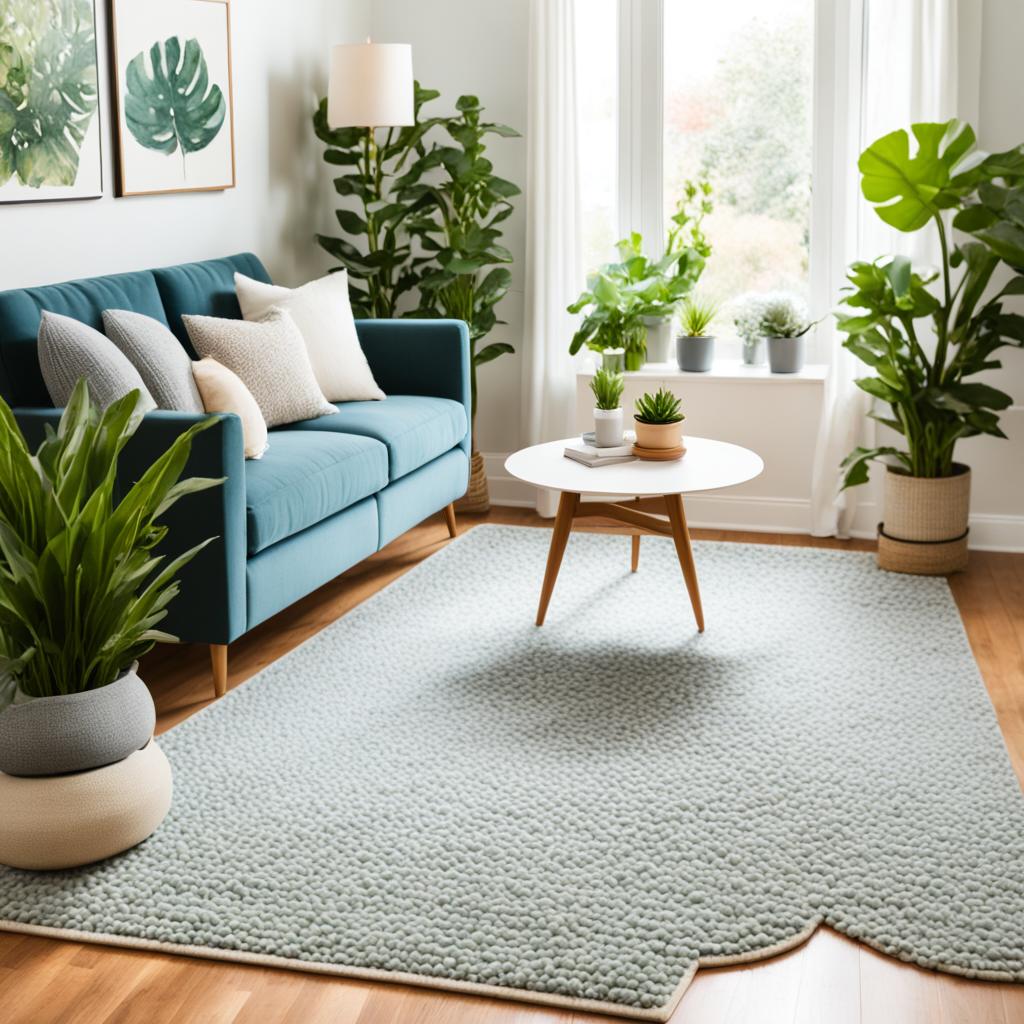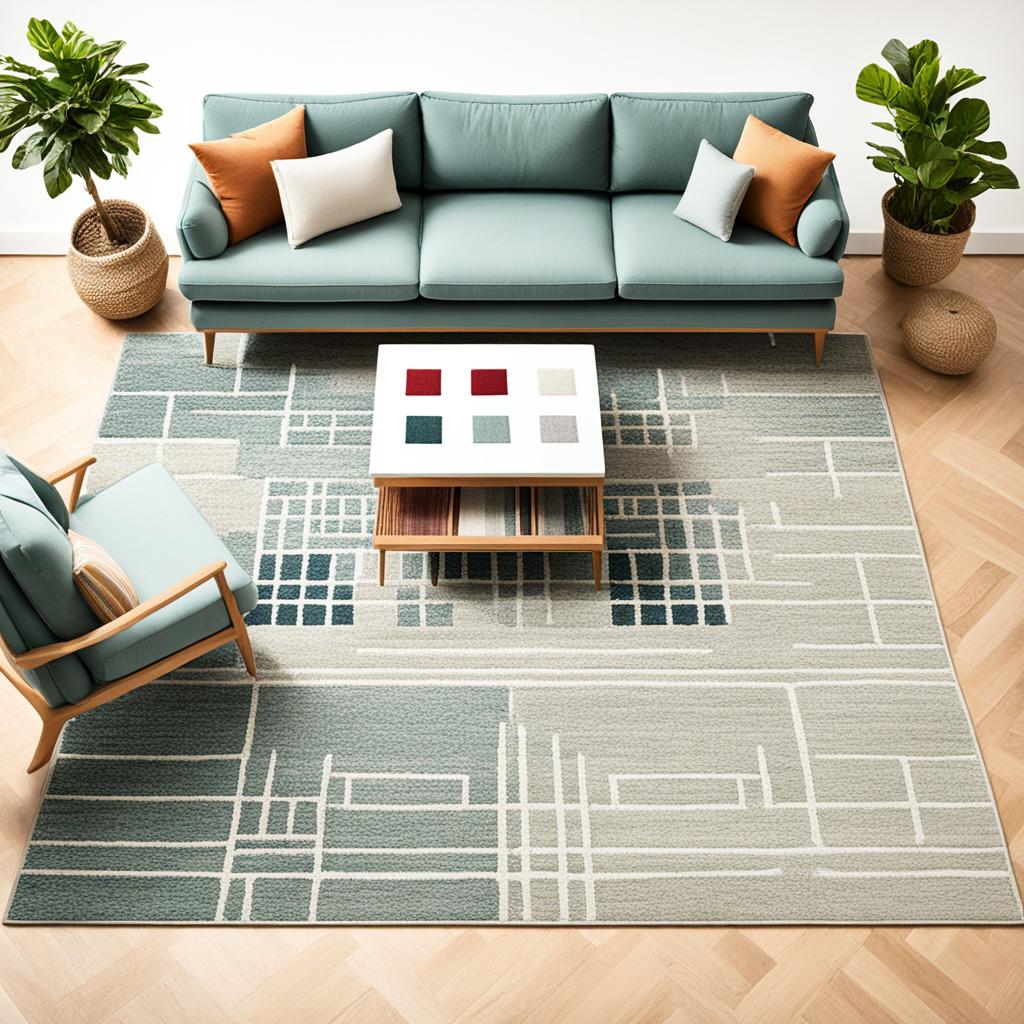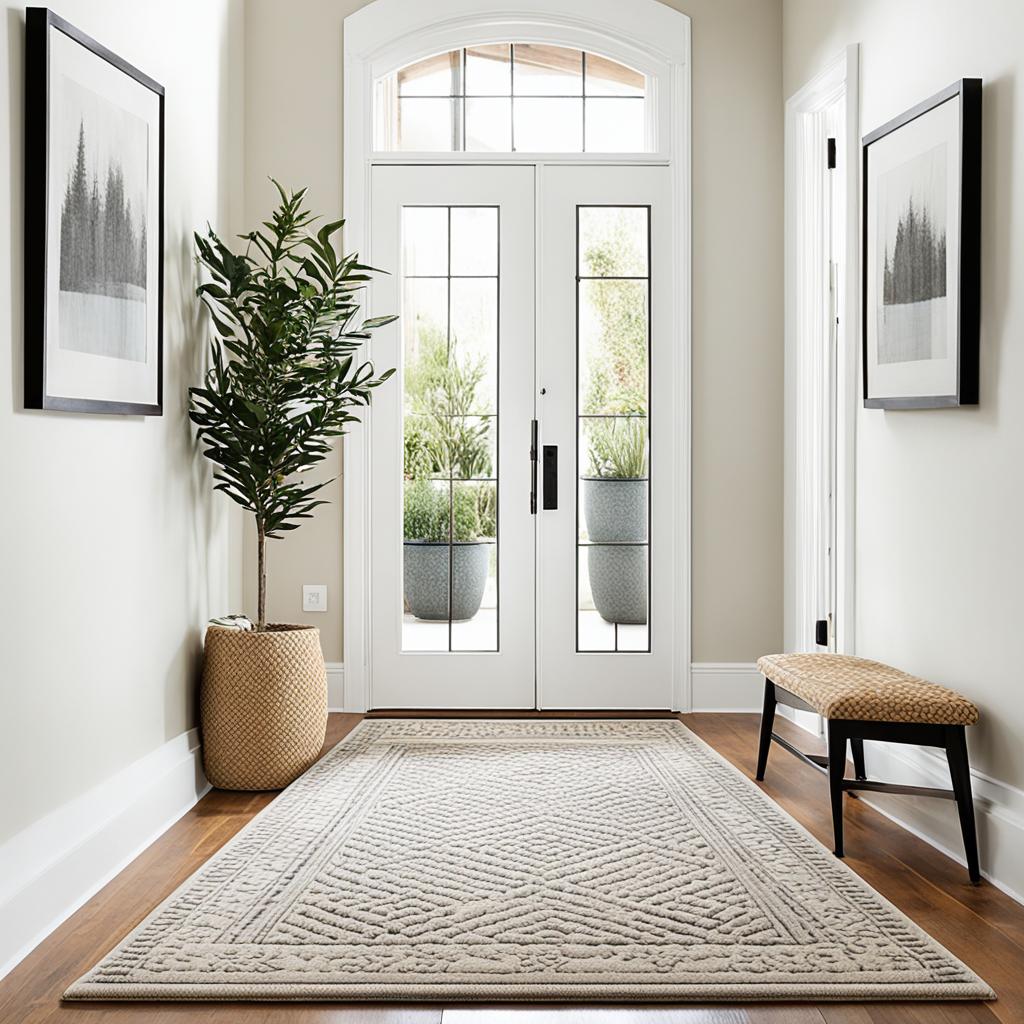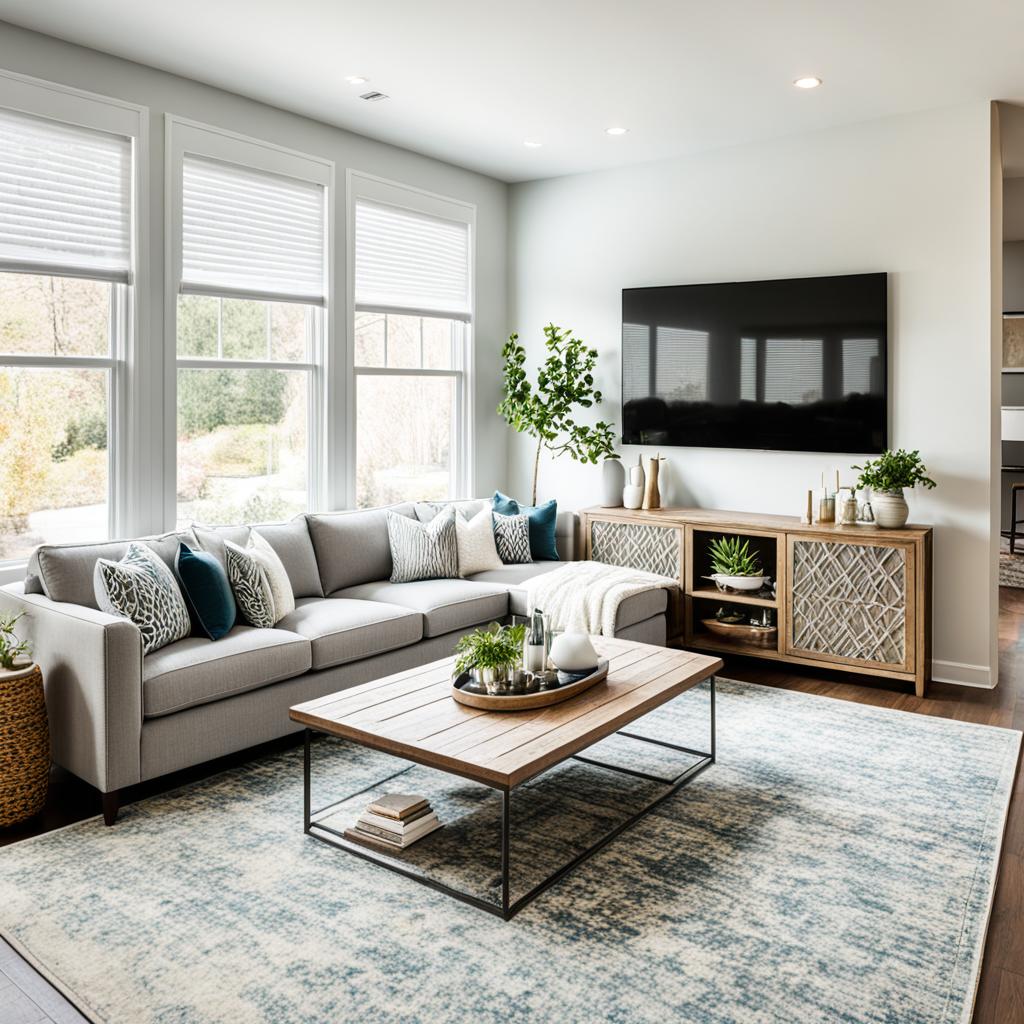The right rug size can transform your living space. It enhances room aesthetics and defines functionality. A well-chosen rug creates a balanced and inviting atmosphere in any room.
Rug sizes impact room proportions significantly. A good area rug anchors furniture and decor. It can make a room feel larger or cozier, depending on your needs.
Room measurements are crucial when picking a rug. Consider traffic flow and furniture placement. Think about the overall layout too.
This guide will help you choose a rug that fits your space perfectly. You’ll learn to navigate the process with ease.
Key Takeaways
- Proper rug fit enhances room aesthetics and functionality
- Consider room measurements when selecting rug sizes
- Rug scale impacts the perceived size of a space
- Account for furniture placement in rug sizing decisions
- Traffic flow patterns influence optimal rug dimensions
- Different rooms may require varying rug proportions
Understanding the Importance of Rug Sizing
The right rug size can make or break a room’s balance. Proper measurements and placement enhance both looks and function. Let’s explore why rug sizing matters and how to avoid mistakes.
Impact on Room Aesthetics
A well-sized rug ties a room together, creating a unified look. Living rooms often use 8’x10′ or 9’x12′ rugs for ample coverage.
Choose a rug at least 6″ wider than your sofa on both sides. This ensures a balanced appearance in your living space.

Functional Considerations
Rug sizing is about practicality too. Leave 30″ to 36″ between large furniture pieces for good traffic flow. In tight spaces, 18″ to 24″ is okay.
Place rugs 10″ to 18″ from walls, or up to 24″ in larger rooms. This defines areas while allowing comfortable movement.
Common Sizing Mistakes to Avoid
A common error is choosing a rug too small for the room. This can make your space feel disjointed.
Always measure your space and consider furniture layout before buying. Avoid rugs that interfere with door swings or get stuck.
| Room Type | Recommended Rug Size | Key Consideration |
|---|---|---|
| Living Room | 9′ x 12′ or 10′ x 14′ | All furniture legs on rug |
| Dining Room | 8′ x 10′ or 9′ x 12′ | Fits table and chairs |
| Bedroom (Queen/King) | 8′ x 10′ or 9′ x 12′ | Extends beyond bed sides |
| Hallway | 2.5′ x 8′ or 3′ x 10′ | Covers main walking area |
Standard Rug Sizes and Their Applications
Picking the right rug size can transform your room’s design. A balanced space needs the perfect rug. Let’s look at standard rug sizes and where they work best.

Small rugs (3×5 or 4×6 feet) suit entryways, kitchens, or accent pieces. Medium rugs (5×8 or 6×9 feet) fit various living spaces. Large rugs (8×10 or 9×12 feet) anchor furniture in big rooms.
| Room Type | Room Size | Recommended Rug Size |
|---|---|---|
| Small Living Room | 150 sq ft | 6’x9′ |
| Medium Living Room | 200 sq ft | 8’x10′ or 9’x12′ |
| Large Living Room | 300 sq ft | 9’x12′ or larger |
| Bedroom (King/Queen) | Varies | 9’x12′ |
| Bedroom (Full/Twin) | Varies | 5’x8′ or 6’x9′ |
| Large Dining Room | Varies | 8’x10′ or 9’x12′ |
| Small Dining Room | Varies | 5’x8′ |
Leave about 18 inches of bare floor around your rug edges. This framing trick creates a polished look. It helps your rug blend perfectly with the room.
Choosing a slightly bigger rug often works better than one that’s too small. Keep this in mind when picking your rug size.
Measuring Your Space: A Step-by-Step Guide
Accurate room measurements are crucial for choosing the right rug size. This guide will help you find the perfect fit for your space.
Tools You’ll Need
Gather these essentials for precise measurements:
- Measuring tape
- Painter’s tape
- Notepad and pen
- Calculator
Accounting for Furniture Placement
Your room layout matters when measuring for rugs. In living rooms, all furniture legs should sit on the rug. For dining rooms, extend the rug 24-36 inches beyond the table.
In bedrooms, rugs should provide 18-24 inches of coverage around the bed.

Considering Traffic Flow
Think about movement patterns when deciding on rug size. Leave 3-6 inches of floor space around rug edges for a polished look.
Use painter’s tape to outline potential rug sizes. This helps you visualize how they’ll fit in your space.
| Room Type | Recommended Rug Size | Placement Tips |
|---|---|---|
| Living Room (<11′ x 13′) | 6′ x 9′ | Front legs of furniture on rug |
| Living Room (standard) | 8′ x 10′ | All furniture legs on rug |
| Bedroom (King bed) | 9′ x 12′ | Extend 2 feet around bed |
| Bedroom (Queen bed) | 8′ x 10′ | Extend to near edge of nightstands |
| Dining Room | 8′ x 10′ or 9′ x 12′ | 24-36 inches beyond table |
These rug placement tips will help you select the right size. A properly sized rug enhances your space’s look and feel.
Rug Size Calculator
How to Choose the Right Size Rug for Different Room Types
The right rug size creates a balanced and inviting space. Let’s explore ideal rug dimensions for various areas in your home. We’ll focus on proper measurements and room layout for rugs.
Living Room Rug Sizing
For living rooms, bigger rugs often work better. Choose a 9′ x 12′ or 10′ x 14′ rug to fit all your furniture. This size unifies the space, with front couch legs resting on the rug.

Bedroom Rug Sizing
Bedroom rug size depends on your bed dimensions. For queen and king-size beds, use 8′ x 10′ or 9′ x 12′ rugs. Smaller beds can use 5′ x 8′ or 6′ x 9′ rugs.
Aim for 2 feet of visible rug on all three sides of the bed. This creates a balanced look in your bedroom.
Dining Room Rug Sizing
Choose a dining room rug based on your table size. The rug should extend 24-30 inches beyond the table edge. Small rooms work well with 5′ x 8′ rugs.
Larger rooms can accommodate 8′ x 10′ or 9′ x 12′ rugs. This ensures a cohesive look in your dining area.
Home Office Rug Sizing
For home offices, consider your desk and chair size. A 5′ x 7′ or 6′ x 9′ rug suits standard desk setups. Larger workspaces benefit from 8′ x 10′ rugs.
Ensure the rug fits both the desk and chair, even when pulled out. This creates a comfortable work area.
| Room Type | Recommended Rug Sizes | Percentage of Use |
|---|---|---|
| Living Room | 9′ x 12′, 10′ x 14′ | 65% |
| Bedroom | 8′ x 10′, 9′ x 12′ | 55% |
| Dining Room | 8′ x 10′, 9′ x 12′ | 70% |
| Home Office | 5′ x 7′, 6′ x 9′ | 45% |
These guidelines are flexible. Consider your unique space and furniture layout when choosing a rug size. Your home’s style should guide your final decision.
Rug Placement Techniques for Various Furniture Arrangements

Rug placement is crucial for creating a cohesive and appealing space. The right layout can transform your room and define traffic patterns. Let’s explore effective techniques for different room setups.
In living rooms, place the front legs of sofas and chairs on the rug. This creates a unified seating area and anchors the furniture. For larger spaces, use a 9′ x 12′ or 8′ x 10′ rug.
With sectional sofas, choose a rug size that allows all pieces to sit partially on it. This ensures a balanced look and ties the seating area together. Leave 6-12 inches of floor space around the rug’s edges.
“The rug should be the foundation of your furniture arrangement, not an afterthought.”
For bedrooms, place the rug under the lower two-thirds of the bed. This creates a soft landing spot and adds warmth. Alternatively, use runners on either side of the bed.
In dining areas, ensure the rug fits all chair legs, even when pulled out. This prevents chair legs from catching on the rug edge. It also maintains a clean aesthetic.
- Living room: Front legs of furniture on the rug
- Bedroom: Rug under lower 2/3 of bed or runners on sides
- Dining room: All chair legs on rug when pulled out
- Home office: Low-pile or flatweave rugs for easy chair movement
For home offices, consider rugs that allow for easy chair movement. Low-pile or flatweave rugs work best in these spaces. They balance style with functionality.
Using these techniques will create harmonious furniture arrangements. Your space’s overall design and flow will be enhanced.
The Art of Layering Rugs: Size Considerations
Layering rugs adds depth to rooms and mixes styles. This technique creates unique looks that complement your space. Size is crucial for achieving the perfect balance.
Combining Different Rug Sizes
Start with a large base rug that fits your room. Area rugs typically measure 6×9 feet or larger. Place a smaller, vibrant rug on top for visual interest.
For example, layer a 5×7 foot patterned rug over an 8×10 foot neutral jute rug.

Creating Depth and Texture
Mix textures and patterns to add dimension. Consider these options for layering:
- Shaggy rugs: Popular for bedrooms and living rooms, providing extra cushioning
- Small accent rugs: Great for defining separate areas within larger spaces
- Outdoor rugs: Resistant to fading and staining, perfect for adding texture to outdoor living areas
Use a rug fit calculator to ensure proper sizing. The base rug should anchor the furniture. The top layer can be more experimental in size and style.
| Base Rug | Top Layer | Effect |
|---|---|---|
| Natural fiber (8×10) | Wool rug (5×7) | Adds warmth and comfort |
| Solid color (9×12) | Oriental rug (6×9) | Elegance and sophistication |
| Indoor/outdoor (10×14) | Washable rug (8×10) | Easy maintenance and style |
Combine different rug sizes and styles thoughtfully. This creates a layered look that enhances your room’s beauty and function.
Special Considerations for Unconventional Spaces
Selecting rug sizes for unique areas can be challenging. We’ll explore entryway rug sizing, room size ratios, and rug sizes for unconventional spaces.
Hallways and Entryways
Runner rugs are ideal for narrow spaces. Leave 6-8 inches of exposed floor on both sides for balance. Smaller rugs like 2′ x 3′ or 4′ x 6′ work best in entryways.

Open Floor Plans
Use rugs to define separate areas in open layouts. Consider room size ratios when selecting pieces. 8’x10′ or 9’x12′ rugs suit living spaces well.
Dining area rugs should extend 24 inches beyond the table. This creates visual boundaries without walls.
Outdoor Living Areas
Choose durable, weather-resistant rugs for patios or decks. Select a size 12 to 24 inches shorter than the space’s perimeter. 5’x7′ or 6’x9′ rugs often fit outdoor setups.
Remember to consider furniture placement and traffic flow.
“The right rug can transform any space, even the most unconventional ones. It’s all about finding the perfect balance between size, function, and style.”
These tips will help you choose the ideal rug size for any unconventional space. You’ll master the art of rug selection for your home.
How to Choose the Right Size Rug for Sectional Sofas
Picking the perfect rug for your sectional sofa can be challenging. Follow rug sizing rules to complement your furniture and room layout. Aim for a rug extending at least 3 to 4 inches beyond the sofa’s edges.
Consider your sectional’s dimensions when measuring for a rug. An 8×10 or 9×12 rug works well for a 100-inch square corner sectional. For a chaise sectional against a wall, try an 8×10 rug.

Room size affects rug selection. Leave about a foot of space between the rug and walls. A 6×9 rug or larger fits nicely with a 75-inch sofa.
Shape matters too! Round rugs can add interest to L-shaped sectionals. A 9 or 10-foot diameter rug works well with most L or U-shaped setups.
“The right rug can anchor your sectional and define your living space, creating a cohesive and inviting atmosphere.”
These rug sizing rules are just guidelines. Trust your eye and choose a size that feels right for your space.
The Role of Rug Shape in Sizing Decisions
Rug shape and size are key factors in room design. The right combination can enhance furniture arrangement and aesthetics. Let’s explore how rug shapes affect sizing choices.
Rectangular Rugs
Rectangular rugs are versatile and suit most room layouts. In living rooms, a 9 by 12 feet rug often works best. It allows all furniture legs to rest on the rug.
For bedrooms, try a 5 by 8 feet rug. Place it partially under the bed, extending out on sides and foot.
Round Rugs
Round rugs soften angular spaces and define areas in open floor plans. They’re ideal for circular dining tables or cozy reading nooks. Size round rugs to extend 24 inches beyond the furniture.
Runner Rugs
Runners are perfect for narrow spaces like hallways, kitchens, and beside beds. Leave 4-5 inches of floor visible on each side. In hallways, cover the main walking area but stop before doors.
Place kitchen runners in high-traffic areas for comfort and floor protection. Rug shape and size greatly influence your overall layout planning.
Match rug shapes to your room’s layout for harmonious, flowing spaces. Bougainville Flooring Super Store in Honolulu offers expert guidance for perfect rug selection.
Conclusion
Choosing the right rug size can transform your home’s style. Living room rugs often range from 8′ x 10′ to 9′ x 12′. Dining room rugs should extend at least 24 inches beyond table edges.
Properly sized rugs can make a room feel complete. In bedrooms, rugs should extend 18-24 inches beyond the bed’s sides and foot. For dining areas, ensure all chairs fit on the rug when pulled out.
Regular maintenance keeps your rugs looking fresh. Vacuum often and get professional cleaning twice a year. NYCleaners offers deep cleaning services for New York City residents.
By focusing on size, placement, and care, you’ll create a harmonious space. Your home will reflect your personal style and look more appealing overall.
